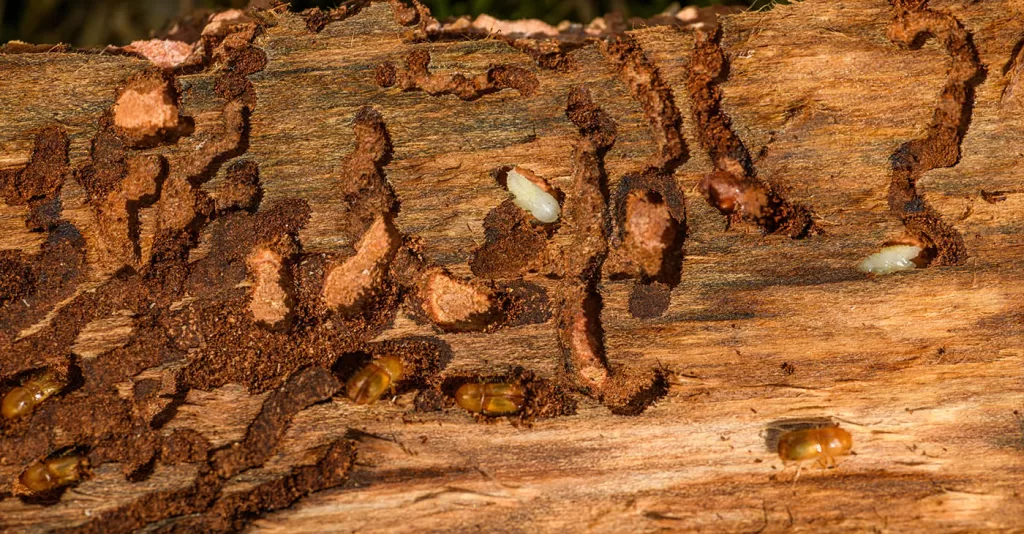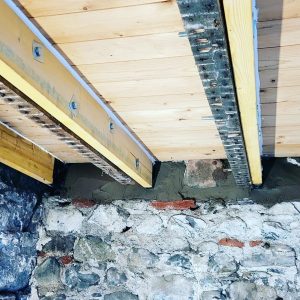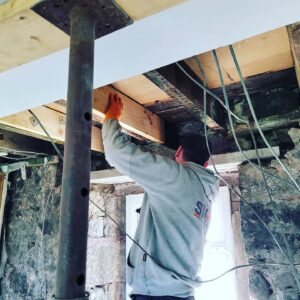OUR SERVICES
WOODWORM TREATMENT
NEED HELP WITH WOODWORM?
CALL US TODAY OR REQUEST A SURVEY ONLINE
What is Woodworm?
Woodworm is a common issue in the UK, and it refers to the larvae or grubs of wood-boring beetles that infest and feed on timber. These tiny creatures can cause significant damage to wooden structures, weakening beams, floorboards, and furniture. The most common wood-boring beetle species in the UK include the Common Furniture Beetle (Anobium punctatum), the House Longhorn Beetle (Hylotrupes bajulus), and the Deathwatch Beetle (Xestobium rufovillosum). Infestations typically start when adult beetles lay their eggs in cracks or crevices in the wood. Once the eggs hatch, the woodworm larvae bore tunnels through the timber, feeding on the cellulose and leaving a network of small, round exit holes on the wood’s surface. Recognising the signs of woodworm and addressing the issue promptly is vital to protect the integrity of wooden structures and prevent further damage.
Woodworm Treatment Specialists
SMPS specialise in Woodworm Treatment, expertly addressing woodworm infestations that commonly afflict properties across the UK. Our seasoned professionals are well-versed in identifying wood-boring beetle species, implementing precise treatments, and safeguarding the structural integrity of your wooden assets, be it beams, floorboards, or cherished furnishings. With a deep understanding of the UK’s unique climate conditions and prevalent wood-boring beetles, we provide tailored solutions to protect your investments and ensure the durability of your wooden structures. Count on us to keep your property free from the damaging effects of woodworm infestations.

What are the common signs of Woodworm in your property?
Identifying woodworm early can save you from costly repairs and health hazards. Watch out for these common signs of woodworm:
Woodworm larvae create exit holes in the timber as they emerge as adult beetles. These holes are typically small, round, and uniform in size, measuring between 2mm to 3mm in diameter. The presence of these holes is a clear indicator of woodworm activity.
Woodworm larvae often produce fine wood dust, known as frass, as they tunnel through the timber. This dust can accumulate around the exit holes or on surfaces beneath infested wood. The color and texture of the frass can vary depending on the wood-boring beetle species.
Infested timber can become weakened, making it prone to crumbling or breaking easily. Woodworm larvae create tunnels as they feed on the wood’s cellulose, compromising its structural integrity.
In some cases, woodworm activity can produce audible tapping or rustling sounds within the affected wood. This is particularly associated with the Deathwatch Beetle (Xestobium rufovillosum) and is more common in older, larger timber.
Adult wood-boring beetles emerge from the infested wood through the exit holes they create. If you see these exit holes with fresh, clean edges, it indicates recent woodworm activity.
Woodworm infestations can lead to cracks or splits in the affected timber, as the wood becomes weakened and less stable.
Infestations in floorboards or wooden furniture can cause loosening of joints and connections due to the weakening of the wood by woodworm larvae.
Sometimes, you may spot adult wood-boring beetles in and around the affected area. The type of beetle can provide clues about the specific woodworm species present.
Identifying these signs of woodworm is essential for early detection and prompt treatment. Different wood-boring beetle species may exhibit these signs to varying degrees, so it’s important to consult with professionals who can accurately identify the specific type of woodworm and recommend appropriate treatment to prevent further damage to your wooden structures and furnishings.
What Causes Woodworm in a Property?
Woodworm infestations in a property are primarily caused by wood-boring beetle larvae that feed on timber and wood-based materials. Several factors can contribute to woodworm infestations, and different types of wood-boring beetles are attracted to various conditions. Here are the common causes, along with explanations for each:
Excess moisture in timber makes it more susceptible to woodworm infestations. Damp or humid conditions can attract wood-boring beetles because they prefer to lay their eggs in moist wood. Leaking roofs, plumbing issues, or inadequate ventilation can introduce moisture and create an ideal environment for woodworm larvae.
Older timber and wood that has not been properly treated are more likely to be targeted by wood-boring beetles. Aging timber becomes more porous, providing easier access for beetle larvae to tunnel and feed.
Some wood-boring beetles have preferences for specific wood species. For example, the Common Furniture Beetle (Anobium punctatum) commonly infests softwood timber, while the Deathwatch Beetle (Xestobium rufovillosum) prefers hardwoods. The type of wood used in a property’s construction can influence the risk of woodworm infestation..
Environmental conditions, such as temperature and humidity, can influence woodworm activity. For instance, certain wood-boring beetles are more active in warmer conditions. The microclimate within a property can impact the likelihood of infestations.
Woodworm infestations often start when adult beetles lay their eggs in cracks, crevices, or existing exit holes in timber. These eggs hatch into larvae that begin to tunnel and feed on the wood, creating the characteristic exit holes and frass.
The presence of infested wood, such as old furniture or untreated timber, within a property can introduce wood-boring beetles. These beetles may spread to other wooden structures within the property.
Lack of proper wood treatment, such as preservatives or coatings, can leave timber vulnerable to woodworm infestations. Regular inspections and preventive measures can help reduce the risk.
Understanding these causes is essential for preventing and addressing woodworm infestations effectively. Identifying the specific type of wood-boring beetle and addressing the underlying factors contributing to the infestation is crucial for successful woodworm treatment and protection of wooden assets in your property.

